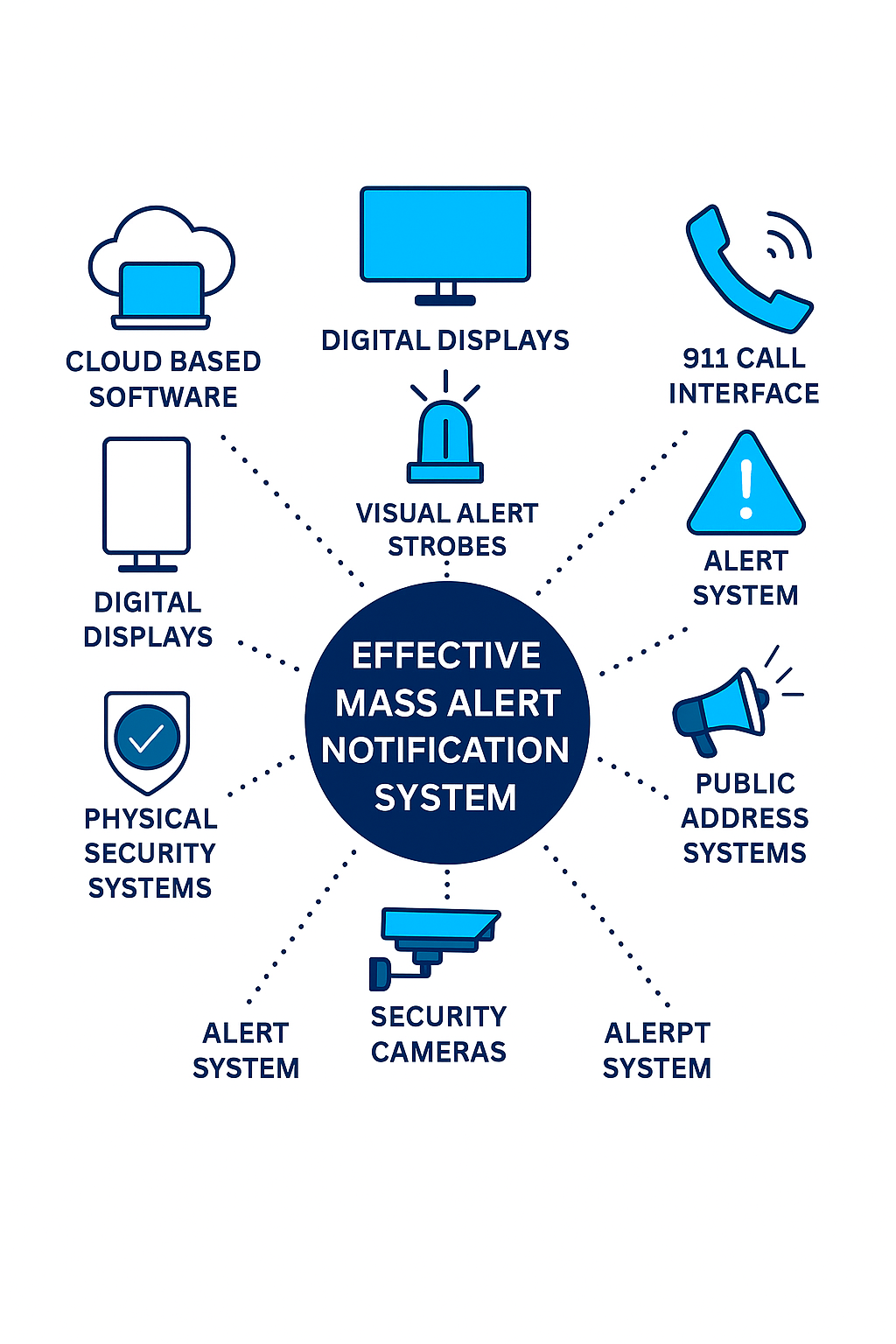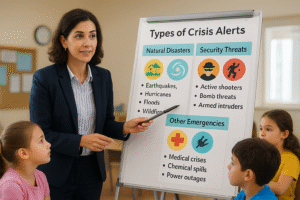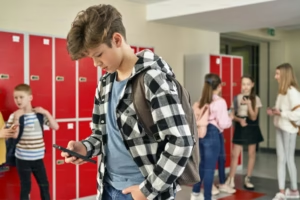Resources

The Future of School Safety: Mass Notification Alert Systems Explained
Introduction
When a school emergency happens — whether it’s a lockdown, severe weather alert, or a medical emergency — the biggest challenge isn’t always the event itself. It is communication.
In critical moments, every second of confusion can mean delayed action, uncertainty, and unnecessary risk.
That’s why more schools are turning to mass notification alert systems — advanced tools that ensure everyone receives the right message instantly, no matter where they are on campus.
In 2025, these systems are no longer just “nice-to-have” technology. They are essential infrastructure — helping schools protect students, empower staff, and comply with evolving safety laws like Alyssa’s Law.
This article explores what a mass notification alert system for schools is, how it works, and the five key ways it’s transforming communication and readiness across K-12 campuses.
What Is a Mass Notification Alert System for Schools?
A mass notification alert system is a centralized platform that allows schools to send emergency alerts to staff, students, and first responders — simultaneously and across multiple channels. It is achieved through the integration of different systems.

fig1: Integrated School Systems’
Unlike traditional systems (like intercom announcements or text trees), modern mass notification platforms use multi-channel delivery, meaning messages can reach recipients through:
- Classroom and hallway screens
- Mobile devices and computers
- Color-coded badges or panic buttons
- Email, text, and voice messages
- Integrated law enforcement alerts
The goal is simple but powerful:
Deliver critical information instantly and clearly, no matter the situation.
Whether it’s a fire evacuation, intruder threat, or weather warning, the system ensures everyone knows exactly what to do — without waiting for someone to make a phone call or announcement.
Why Schools Need a Modern Mass Notification System
School environments are complex. They span multiple buildings, include hundreds (sometimes thousands) of people, and rely on staff with varying levels of training.
In an emergency, traditional tools like walkie-talkies, PA systems, or emails can’t keep up.
Here are a few reasons modern schools are investing in mass notification systems:
Communication gaps cause panic and delay: Many incidents escalate because not everyone receives the message at the same time.
Drills don’t always reflect real-world readiness: Staff often perform well in controlled drills but freeze under pressure when communication fails.
Compliance requirements are increasing: States adopting Alyssa’s Law mandate panic alert systems that can contact law enforcement directly.
Parents and communities expect transparency: In today’s connected world, safety communication isn’t optional — it’s a matter of trust.
How Mass Notification Systems Work
A school’s mass notification system is like its digital nervous system — sensing, processing, and transmitting vital information in real time.
Here’s how it typically functions:
Trigger: A staff member presses a color-coded badge, panic button, or mobile alert (e.g., “Lockdown” or “Medical”).
Verification (Optional): In some systems, administrators can verify or confirm the alert before it goes live.
Distribution: The system sends alerts instantly to designated groups — staff, students, first responders — via text, app notification, screens, and speakers.
Response Guidance: Recipients get clear instructions (e.g., “Lock doors and move away from windows”).
Resolution: Once the situation is resolved, an “All Clear” alert goes out, signaling a safe return to normal operations or start of reunification.
This streamlined, automated flow eliminates the chaos that often accompanies manual communication processes.
5 Ways Mass Notification Alert Systems Are Transforming School Safety
- Instant Alerts Reduce Response Times
In an emergency, delays cost lives. A mass notification alert system ensures that alerts are sent to everyone — instantly. Whether it’s a security threat, fire, or severe weather, the system notifies every staff member, classroom, and administrator in seconds. This kind of speed allows schools to:
- Contain threats faster.
- Reduce confusion during evacuation or lockdowns.
- Alert emergency responders without waiting for a manual call.
Example:
A staff member notices an armed intruder forcing their way in. Instead of calling the office, they tap the red “Lockdown button” on their SimulAlert badge. Within seconds, the entire school is notified, and first responders are dispatched automatically.
- Multi-Channel Communication Prevents Missed Messages
Not everyone is in front of a computer or near an intercom during a crisis.
That’s why multi-channel communication is vital. Modern systems like SimulAlert, through integration with other systems, ensure that alerts reach:
- Classroom projectors and TVs
- Staff smartphones
- Desktop pop-ups
- Speakers and hallway alarms
- Law enforcement and 911 operators
If one channel fails, others fill the gap. This redundancy ensures that no one misses critical information — even during power outages or poor connectivity.
- Simplified Color-Coded Alerts Improve Clarity
Complex codes and confusing terminology can lead to hesitation. To solve this, many schools use color-coded alert systems as part of their emergency notification strategy. Each color represents a specific type of emergency:
🔴 Lockdown – Security threat or intruder.
🔵 Medical – Health-related emergency.
🟡 Admin Assist – Minor issue requiring staff support.
🟢 All Clear – Situation resolved.
This visual simplicity allows every staff member — even substitutes and new hires — to understand instantly what action to take.
Result: fewer mistakes or false alerts, faster reactions, and calmer environments.
- Integration With Law Enforcement and Emergency Responders
In a growing number states (USA), new safety laws require schools to have alert systems that directly contact law enforcement during emergencies. Alyssa’s Law, named after Alyssa Alhadeff, a victim of the 2018 Parkland school shooting, emphasizes exactly this: speed and direct communication.
Modern mass notification systems meet and exceed these requirements by integrating with:
- Local police dispatch systems
- 911 communication centers
- Municipal emergency networks
This ensures that law enforcement is automatically notified the moment an alert is triggered. This integration cuts down precious response time — often from minutes to seconds — and can be the difference between safety and tragedy.
- Building a Culture of Readiness
Perhaps the most significant change isn’t technological — it’s cultural. Mass notification systems help schools create a culture of readiness where safety becomes a shared responsibility.
When every staff member has the ability to trigger alerts and access information instantly, it fosters confidence and collaboration. Teachers, custodians, and administrators no longer wait for direction; they act with clarity and assurance.Over time, this builds:
- Confidence – Staff know exactly how to respond.
- Calm – Clear alerts reduce panic during real incidents.
- Consistency – Every staff member follows the same protocol.
- Trust – Parents and students feel safer knowing the school is proactive.
In other words, technology doesn’t replace human action — it empowers it.
Additional Benefits of Mass Notification Systems
Beyond emergencies, these systems are proving useful in day-to-day operations as well.
Schools are now using them for:
- Weather-related schedule changes
- Early dismissals or transportation updates
- Power outages or maintenance alerts
- Large event coordination
Because these systems are flexible, schools can send targeted messages to specific groups — teachers, students, or parents — ensuring the right people receive the right message at the right time.
This makes alert technology not just an emergency solution, but a tool for everyday efficiency.
Common Challenges Schools Face Without a Notification System
Even schools with strong leadership and policies can face problems when they rely on traditional communication tools:
- Delayed responses due to manual calls.
- Confusion from unclear announcements.
- Staff hesitation because of uncertainty about protocols.
- Lack of coordination between departments.
- Parent anxiety from poor communication during incidents.
By adopting a modern mass notification alert system, schools eliminate these challenges and move toward an environment where everyone — from students to superintendents — feels informed and secure.
Choosing the Right System for Your School
When selecting a mass notification platform, schools should look for:
✅ Speed: Instant, multi-channel alert delivery.
✅ Simplicity: Easy for every staff member to use.
✅ Integration: Connects with law enforcement and local 911.
✅ Customization: Configurable alerts for different scenarios.
✅ Scalability: Works for small private schools and large districts alike.
✅ Training Support: Includes onboarding and refresher resources.
SimulAlert, for example, was built around these exact principles — combining color-coded clarity, real-time dashboards, and instant communication to make school safety both simple and effective.
Conclusion
In today’s world, safety isn’t just about being reactive — it’s about being ready.
A mass notification alert system for schools ensures that when emergencies happen, communication is instant, clear, and effective.
From color-coded badges to integrated alerts with law enforcement, this technology empowers schools to protect what matters most — their students and staff.
As school environments continue to evolve, the message is clear: Readiness starts with clear communication
Ready to modernize your school’s emergency communications?
Book a Free Demo with SimulAlert
Discover how our our alert system can help your school reduce response times, improve coordination, and build a culture of readiness.



